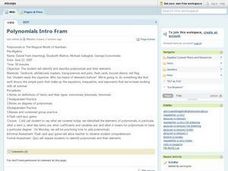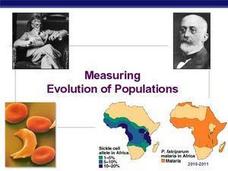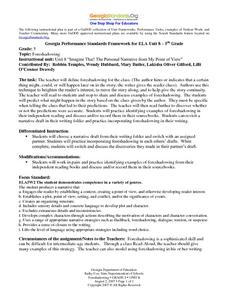Curated OER
Middle Ages Center: Games--Build-A-Knight
In this Middle Ages vocabulary terms instructional activity, students participate in a game that deals with four game cards and the unscrambling of letters to create Middle Ages terms of interest.
Curated OER
Integers
In this integers worksheet, 8th graders solve 10 various types of problems to include rewriting each statement using the convention for Positive integers and then calculate their answer. They also rewrite each statements without the...
Curated OER
Uncertainty Worksheet
In this uncertainty worksheet, students solve 8 problems of addition and subtraction using the rules for uncertainty notation. They do the same for 7 problems for multiplication and division. Students add, subtract, multiply and divide...
Curated OER
Let's go shopping
Students work in groups to write a skit in the target language (in this case, English) in which they are on a shopping trip. The teacher plays the part of the clerk. Students practice the vocabulary required, and perform their skits for...
Curated OER
Solving Equations with Variables on Both Sides
In this solving equations worksheet, students solve 15 equations with variables on both sides of the equal sign. Students are encouraged to check all solutions.
Curated OER
Gases and Chemical Reactions
In this chemical reactions worksheet, students calculate the volume or pressure for different gases. Students determine the effect of different stimuli on the rate of a chemical reaction. This worksheet has 1 short answer, 10 fill in the...
Curated OER
DNA Isolation
Students use scientific methods to investigate the concept of DNA. They observe the DNA of human cheek cells. This is done with the use of a lab experience. Students record their observations and reflect upon on how each organism is...
Curated OER
Subject Verb Agreement
Seventh graders engage in a lesson plan that investigates the concept of identifying prepositions and their coinciding phrases. They also develop the skill of connecting the right form of a verb with its subject. Then students take a...
Curated OER
Combinatorial Games
In this games worksheet, students play games such as tic-tac-toe, poison cookie, numbers games, box games, and more. Students play six higher order thinking math games.
Curated OER
Polynomials in The Magical World of Numbers
Students identify and describe polynomials and their elements, discuss simple parts that make up equations, inequalities, and exponents, take notes on definitions of terms and their types, including monomials, binomials, and trinomials,...
Curated OER
Solving Literal Equations: Worksheet SE4
In this solving literal equations activity, students solve 30 equations. Students solve each equation for a given variable, but do not solve for a number answer.
Curated OER
Introduction of Single and Multiple Linear Inequalities
Students solve linear inequalities. In this algebra lesson, students rewrite inequalities using one and two step equations. They graph their findings and identify the slope and solution of the line.
Curated OER
Measuring Evolution of Populations
The five agents of evolutionary change are reviewed in this slideshow. Definitions of common terms involved with populations and equilibrium are given, and there are some presentations of Hardy Weinberg equations for common examples of...
Curated OER
DNA Profile Analysis
Pupils obtain a DNA sample, observe DNA Using Agarose Gel Electrophoresis, and obtain reagents and equipment.
Curated OER
Foreshadowing
Students read and discuss Act V, Scene 1. They define foreshadowing and identify examples of it from the text. They edit a partner's diary entry. They identify key ideas from the scene.
Curated OER
Making Connections, Linking Population and the Environment
Students find out that all habitats have a carrying capacity. They explore how the world's human population has grown markedly in the 20th century, and that humans impact environmental health. Students investigate that people can and...
Curated OER
Let's Read! Growing Vegetable Soup
Young scholars state that vegetables come from plants. They identify a vegetable they can eat at home.
















